Tallinn (Estonia) – the most detailed information about the city with photos. The main attractions of Tallinn with a description, guides and cards.
Contents
Tallinn City (Estonia)
Tallinn – the capital of Estonia, one of the largest and most beautiful cities of the Baltic States, located on northeast coast of the Baltic Sea. Is large port and the most interesting city of Estonia. Tallinn represents is a wonderful combination of antiquity and modernity. Special impressive well-preserved old town that is included in UNESCO World Heritage List. Historical Center Tallinn is a charming atmosphere of the Middle Ages and the old Hanseatic City: city wall with towers, interlacing winding cobbled streets, old houses, interesting attractions, historical and architectural monuments.
- Practical information
- Best time to visit
- Geography and climate
- Story
- How to get there
- Movement around the city
- Shopping
- Where to eat
- Night life
- Tallinn Attractions
- Sacred architecture
- Interesting places
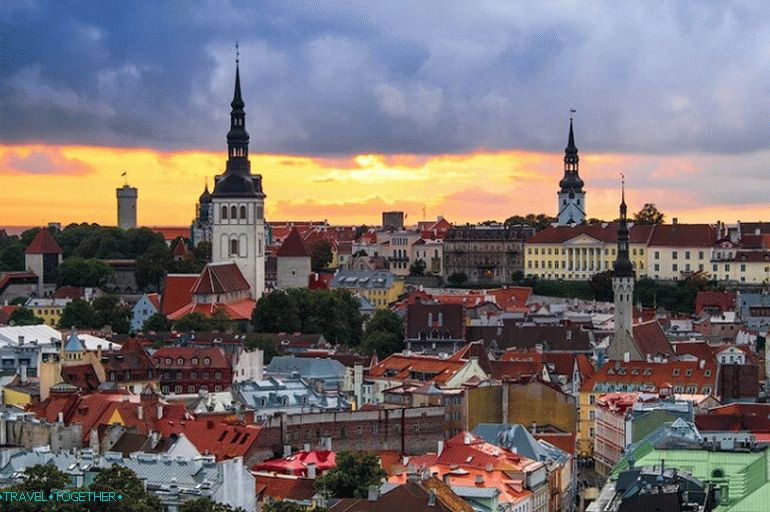 Panorama of Tallinn
Panorama of Tallinn
Tallinn can be divided into two parts: the new and the old city. Old Town includes:
- Toompea hill (Vyshgorod) – a medieval fortress with old streets covered with paving stones, medieval houses and monuments the history and architecture that surround the fragments of the urban walls
- the lower city is adjacent to the city wall and lies at the base the hill.
The new city contrasts strongly with the historic center, representing a classic Soviet building, diluted modern high-rise glass and concrete.
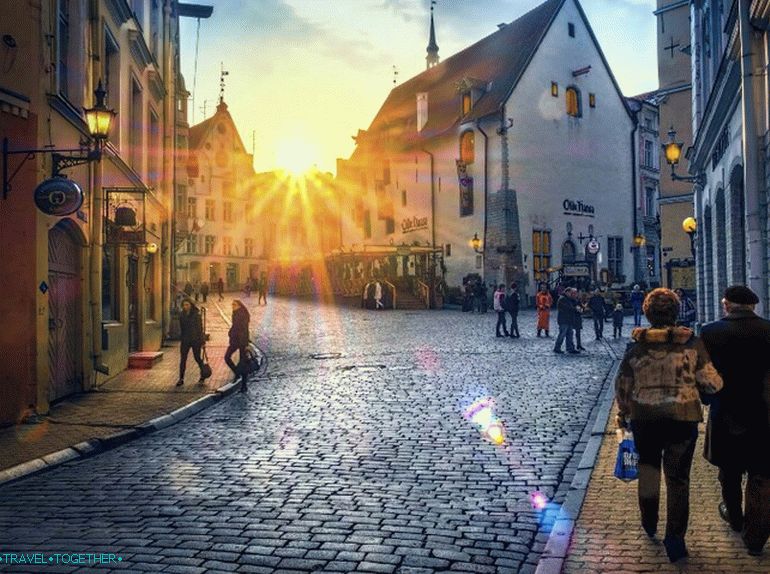 Streets of the Old Tallinn
Streets of the Old Tallinn
Practical information about the city
- The population of Tallinn is about 450 thousand inhabitants. Of them more than 50% are Estonians and almost 40% are Russians.
- The state language is Estonian. Very common Russian. In the course also English and German.
- Currency – Euro. Almost everywhere take banking cards.
- Orthodox denominations predominate among religious denominations. Lutheran.
- Time: winter +2, summer +3.
- Visa – Schengen.
Best time to visit
Despite the fact that Tallinn is beautiful and interesting in any weather, We consider the best time of the visit to be summer and the beginning of autumn (before October). At this time, quite warm and usually good weather. Another magical time is New Year and Christmas. In it time in Tallinn reigns fantastic atmosphere, Christmas pass fairs and bazaars.
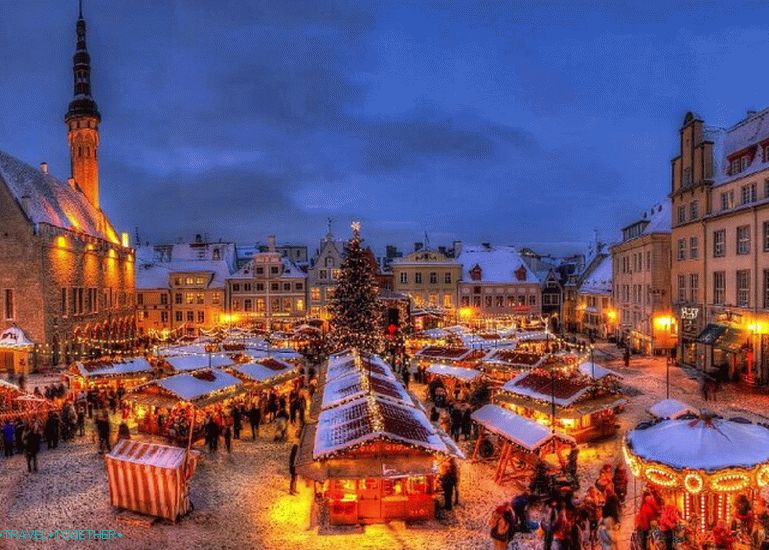 Christmas market in Tallinn
Christmas market in Tallinn
Geography and climate
Tallinn is geographically located in northern Europe in the southern part Gulf of Riga, which enters the Baltic Sea in 80 km from the capital of Finland – Helsinki. The terrain is fairly flat. The highest point of Tallinn (64 m) is located in its south-west parts. In the city there are several large lakes the largest of which is Ülemiste.
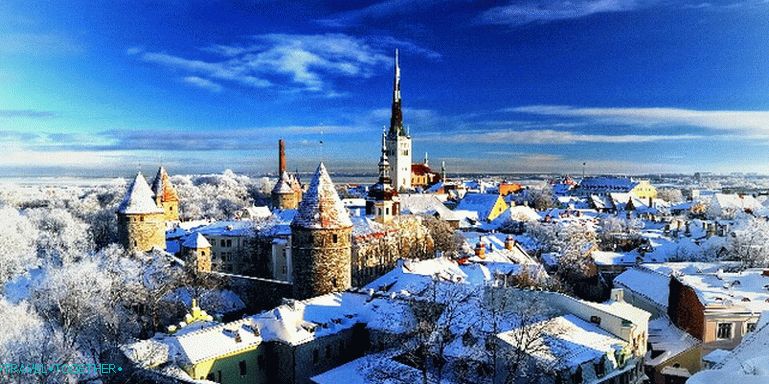 Winter Tallinn
Winter Tallinn
The climate of Tallinn is temperate sea with high humidity. For Tallinn’s climate is typical: a fairly mild winter with small frosts and thaws, cool spring, warm summer and rainy autumn. The average temperature of July-August is 15-20 degrees.
Story
Tallinn is a rather old city. His story counts more than 8 centuries. The first written records of the city date back 1154 year. Then there was a market and fishing harbor. In the first Half of the 13th century Tallinn was captured by the Danes. They destroyed old settlement and began building a new one. At that time the city called Revel. At the same time, Tallinn constantly raided Estonian and German knights. In 1227, the German knights captured city but he returned to Denmark again in 1238 and belonged the Danish kingdom for over 100 years. About this time is the foundation of the coat of arms of Tallinn.
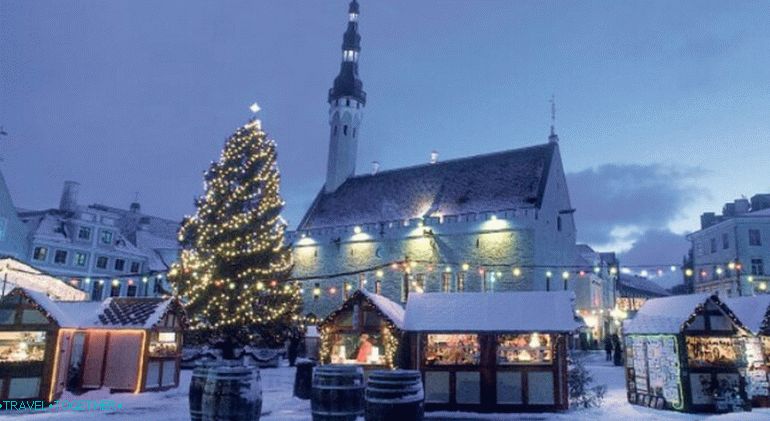 Christmas Tallinn
Christmas Tallinn
In 1346, Revel was sold by Denmark along with part of Estland. Teutonic Order. The heyday of the 14th and 16th centuries of ancient Tallinn. In 1347, Revel receives city privileges and soon enters the Hanseatic League. Hanse membership has turned Tallinn in one of the richest cities in the Baltic States.
During the Livonian War, the Order of the same name ceased its Existence. In 1561, Revel swore allegiance to the Swedish to the king. At the same time Tallinn became one of the main trade cities in Sweden, surpassing even the Swedish capital – Stockholm. AT During the Livonian War, the city was besieged by Poles, Danes, 3 months near he stood Russian troops. The result of this military campaign there was a decline in trade, and Tallinn lost its meaning. In 1583 The city became the center of the Duchy of Estland as part of Sweden. The era of Swedish rule continued until the 18th century. In this period fortress walls were erected.
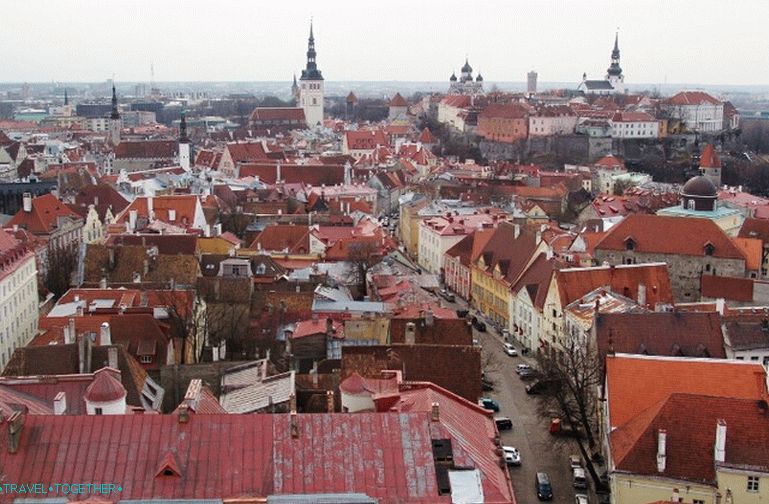 Panorama of Tallinn
Panorama of Tallinn
After the end of the Northern War, Revel became part of the Russian empire. At this time, the city becomes one of the central ports. Russian Baltic on a par with St. Petersburg and Riga. Composed Russian Empire Tallinn was until 19 18.
In 1918, the independence of Estonia was proclaimed in Reval. AT 1919 the city was renamed Tallinn. In 1940, Estonia entered the composition of the USSR. In 1941, Tallinn was occupied by the Germans. In 1944 year the city was liberated. During the liberation the city was subjected to bombardments during which 40% were damaged old town. Since 1991 Tallinn is the capital of independent Estonia.
How to get there
Tallinn International Airport is located 5 km from historical center. There are flights from Moscow, Amsterdam, Berlin, Munich, Bremen, Oslo, Copenhagen, Kiev, Istanbul, London, Milan, Bergamo and many other European cities. Of Airport bus runs to the center ✓ 2 (every half hour, a ticket costs 2 euros) and tram ✓ 4 (ticket also costs 2 euros). Taxi to center costs about 10 euros.
Ferry service connects Tallinn with Helsinki. Also by sea You can get to the capital of Estonia from Stockholm and St. Petersburg.
By bus you can get to Tallinn from almost all major cities of the Baltic States, Finland, St. Petersburg, etc. Buses come to the central bus station, located on the street. Lastekodu, 46. From the bus station to the center you can get by buses17, 23, 2, 54, 15 and trams 4, 2.
The trains arrive at the Baltic Station, located not far from old town. Railway communication is established with Moscow and St. Petersburg. Highways connect Tallinn with Russia and Latvia.
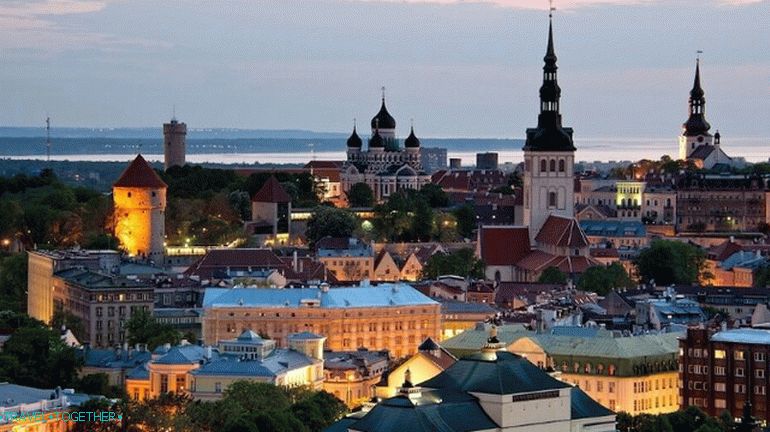 View of Tallinn’s historic center
View of Tallinn’s historic center
Movement around the city
To get around the city, you can use buses trolley buses and trams. Tallinn’s public transport operates from 6.00 to 23.00 (although some lines may work until 24.00). Scheme public transport can be viewed / downloaded below. Old the city is quite compact, so it is easy to move around on foot. The fare for cash payments is 2 Euro. Tickets can be bought from the driver. You can also use the TallinCard, which gives you the right to free public transport on the entire period of its action or a single travel card. Wherein card validation should be carried out immediately after the start of the trip.
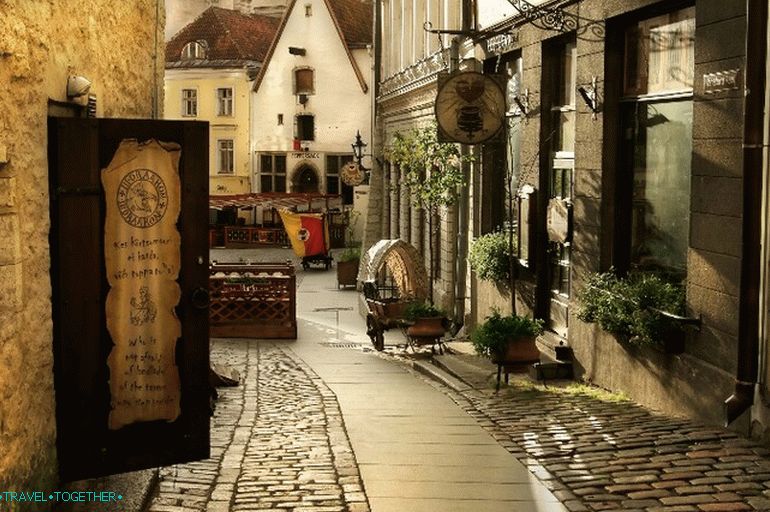 On the streets of Tallinn
On the streets of Tallinn
Shopping and shopping
Tallinn is one of the shopping centers in the Baltics. Main trading quarter is Rotermann, where you can find a lot of shops and restaurants. Many shops and souvenir shops and not only can be found in the old town.
Shopping centers and large supermarkets in Tallinn:
- Viru Keskus, Viru väljak 6
- FoorumKeskus, Narva maantee
- Kristiine, Endla 45
- Stockmann, Liivalaia 53
- Solaris, Estonia pst. 9
- Norde Centrum, Lootsi 7
- WW Passaaž, Aia 3 / Vana-Viru 10
- Sikupilli, Tartu mnt 87
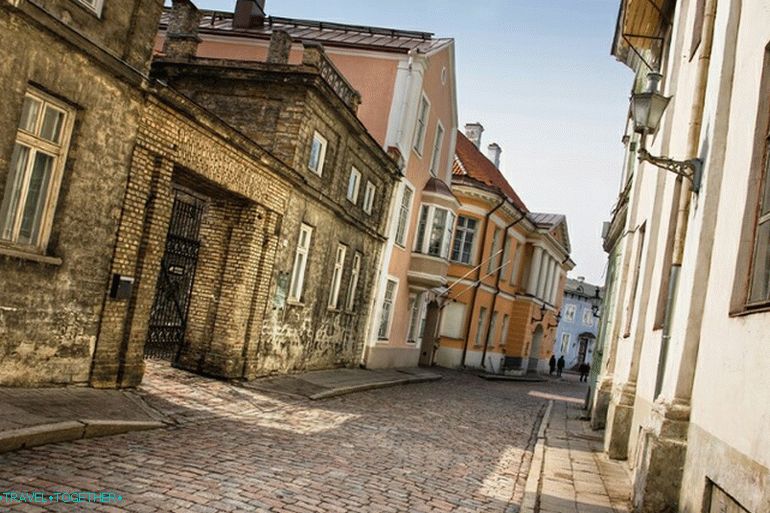 Tallinn streets
Tallinn streets
Where to eat
Many restaurants and cafes are located in the old town. Great Food (including traditional Estonian cuisine) can be enjoyed at the area around Raekoja (Town Hall Square). Although in restaurants on this square, the food by Estonian standards is expensive. Unusual and inexpensive establishments can be found in the districts of Kalamaja and Kopli.
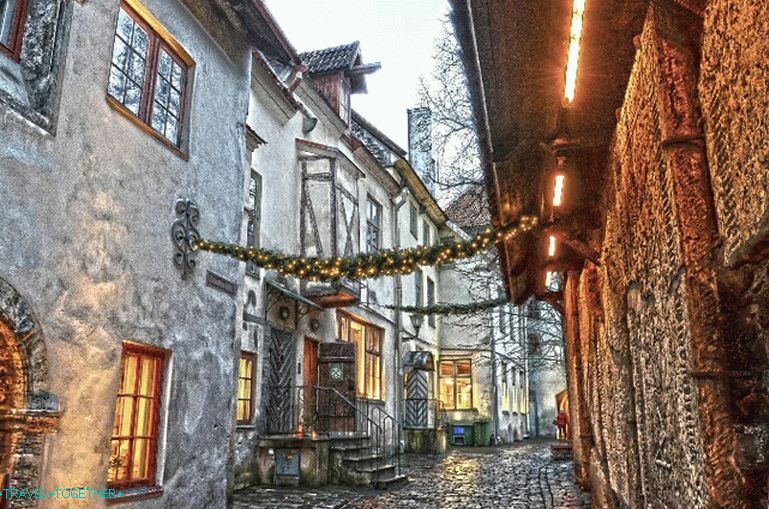 Tallinn streets
Tallinn streets
Night life
In terms of entertainment, Tallinn is in no way inferior to the most fashionable. European capitals. Therefore, even avid party people here are not will be boring. Tallinn clubs usually work on Friday and Saturday and holidays, although here you can always find a fun institution. Clubs open from 22.00 – 23.00 and work until 3.00 – 4.00. Plus Tallinn is its compactness, so if not liked in one place, then you can walk to another.
Interesting events in Tallinn, see here – https://www.visittallinn.ee/rus/visitor/see-do/events.
Tallinn Attractions
The main attraction and symbol of Tallinn is Old city. This is an amazingly beautiful place with wonderful an atmosphere that is surprisingly well preserved despite everything war and adversity. Old winding cobbled streets, medieval the architecture, the gothic spiers of churches and street lamps introduce us with the history and culture of Tallinn and give it some kind of mystical Charm.
The historical center of Tallinn was formed from 13 to 15 century in the era of the Hanse. The old town largely preserved the original layout and even building. He was surrounded by a powerful serf wall, fragments of which have survived to this day. This place atmospheric red tiled roofs, old stone houses, cozy courtyards and monuments of history and culture.
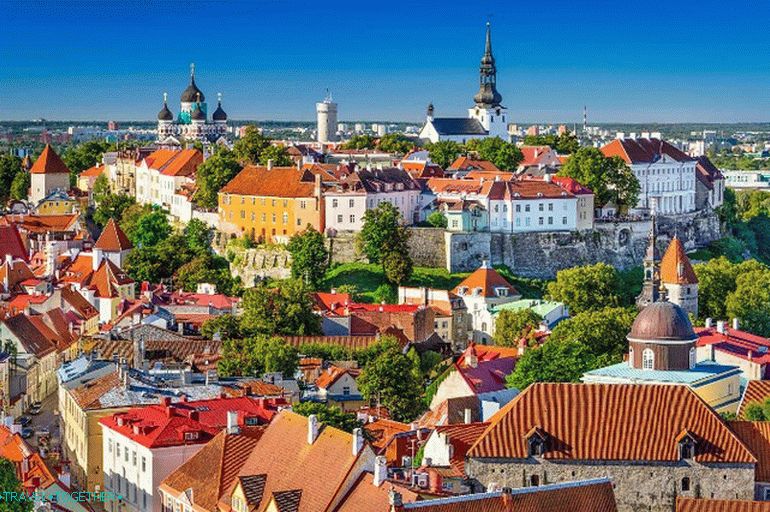 View of Tallinn’s historic center and upper town
View of Tallinn’s historic center and upper town
Initially, the old city was divided into Upper (Toompea or Vyshgorod) and Lower. In the Upper vein the nobility and rich people of Tallinn, in Nizhny, artisans and other poor people. Upper city was divided with the lower gate. Now these two parts form a single historical and architectural ensemble.
 Toompea Castle in Tallinn
Toompea Castle in Tallinn
The main attraction of the Upper Town is the castle Toompea, which rises on a cliff above Tallinn. it The city’s oldest site, founded by German knights in the first half of the 13th century. Throughout Tallinn’s history, Toompea Castle was the center of power. Now there is a parliament. Behind almost 8 centuries of its history, the castle was rebuilt many times, but during largely retained its original structure of the fortress 13-14 centuries. On the south side of the castle you can see the tower Long Hermann. This 46 meter stone community is the Estonian national symbol. Every morning the flag of Estonia rises on it.
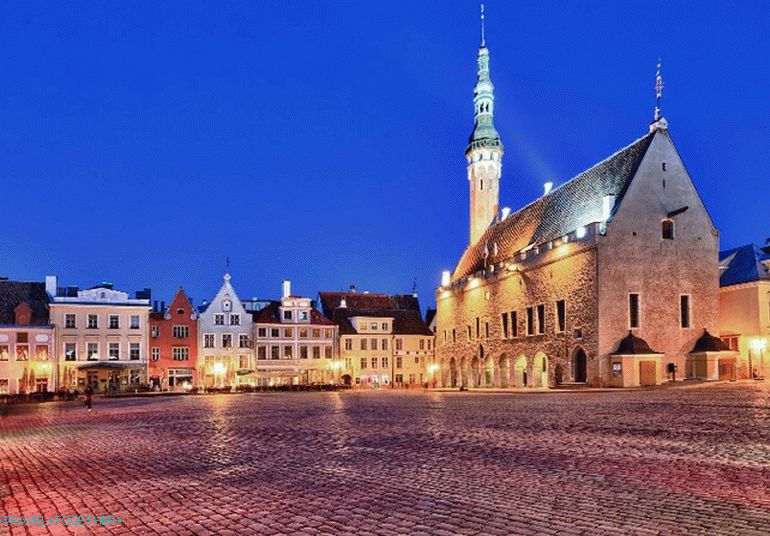 Town Hall Square
Town Hall Square
The heart of the old city is the Town Hall Square, which is almost the same age as Tallinn. Along the perimeter area surrounded by old houses. In the summer there are street cafes, and winter Christmas tree. It is interesting that the tree is set to Town Hall Square from the first half of the 15th century.
The main attraction of the square, as it should be, is the town hall, which is a beautiful Gothic structure, built at the beginning of the 15th century. Interestingly, Tallinn Town Hall is the only fully preserved in the entire North Europe. The most big-eyed may consider the symbol of the town hall – a figure of Old Thomas. In the summer of the most physically prepared tourists can climb the 64 meter tower and enjoy wonderful view of Tallinn.
Next to the Town Hall is the oldest pharmacy in Europe, which works from the 15th century.
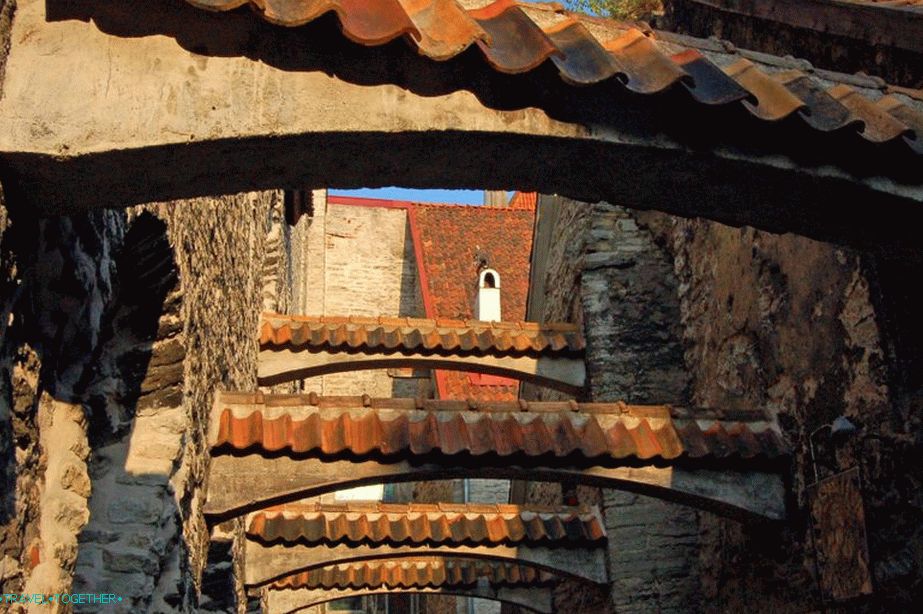 Katharina Street
Katharina Street
In Old Tallinn you can find many beautiful, romantic and atmospheric places. One of the most picturesque streets is Katharina Lane. Here is the most famous market souvenirs. Quite an interesting place is the Courtyard of the Masters, located on st. Vene tn 6. Some of the oldest are preserved here. medieval buildings.
On the eastern side of Toompea is located one of the most Tallinn’s photogenic sites – lookout Kokhutotsa. Here you can not only enjoy the beautiful view of the old city, but also make cool photos.
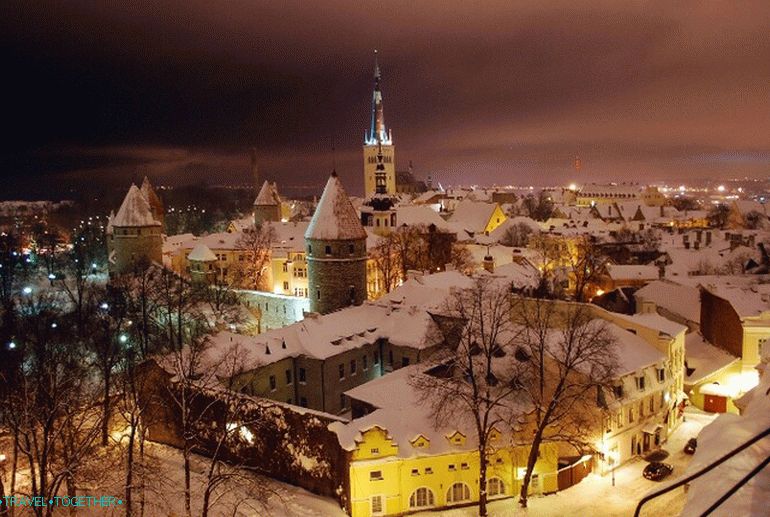 City wall
City wall
The real symbol of Tallinn is the city wall. Earlier The lower town was surrounded by a 4-kilometer wall with 46 towers. Before Today, about 2 km of the wall and 20 towers have survived. Building The wall was begun in the 13th century. But most of it belongs to 16 century to the heyday of Tallinn as the trading city of the Hanseatic union. The height of the wall is 14-16 meters, and the thickness reaches 3 meters
In the northwestern part of the old town, a part of city wall with three towers. Here you can climb the wall and even walk on it. A beautiful view of the city walls opens with viewing platform on Vyshgorod (Toompea) and Tower Square, located near the railway station. Some city towers the walls are open to the public and contain lubotnye exposure.
Sacred architecture
In Tallinn, you can find several masterpieces of sacred architecture.
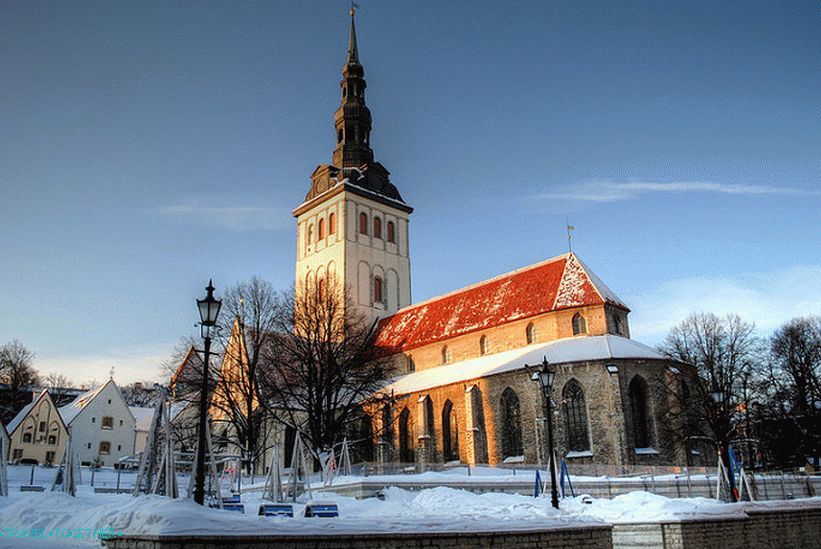 Church of sv. Nikolay
Church of sv. Nikolay
Church of sv. Nicholas – 13th century church dedicated to the patron seafarers. It is a powerful building built according to order of German immigrants before the walls. Interesting that This religious building is the only one in the Lower a city that did not suffer during the Reformation. Church of sv. Nicholas was damaged during World War II and later restored. Now it is a museum. Here you can admire on unique altar, ancient tombstones and sacred masterpieces art.
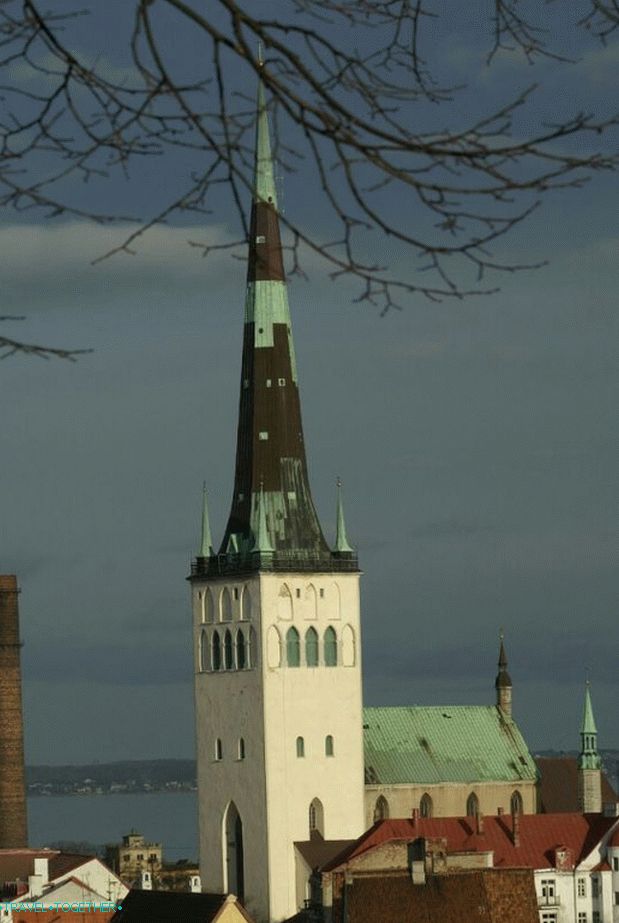 Church of sv. Olav
Church of sv. Olav
Church of sv. Olava – one of the most famous churches in the Baltic States. This is a beautiful Gothic structure, known for its high tower, which in 15-16 centuries was the highest building in the world. Church was built in the 13th century for Scandinavian merchants. Modern appearance acquired in the 15-16 century. At that time, the height of the spire reached 159 meters. The spire of the church became not only the symbols of Tallinn, but even served as a guide for ships. Several times in history the spire was damaged by lightning. Now the height of the tower is 124 meter
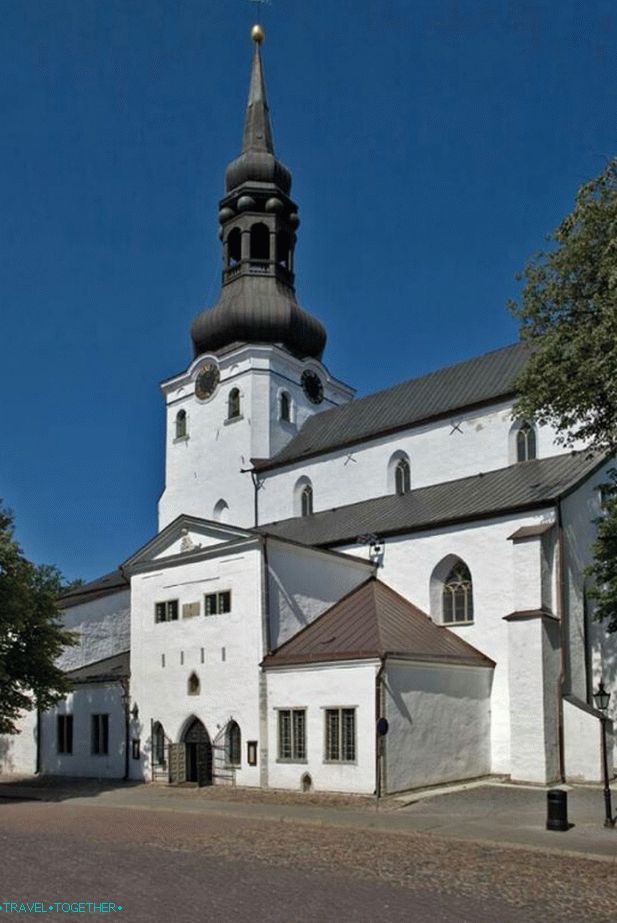 The Dome Cathedral
The Dome Cathedral
Dome Cathedral – one of the oldest religious buildings in Tallinn and Estonia. The exact date of the construction of the church is not known. But there is evidence of its existence in the first half 13th century. The church was built for the German community. The oldest part refers to the 14th century. 69 meter baroque tower built in the 18th century. The famous navigator I.F. Krusenstern.
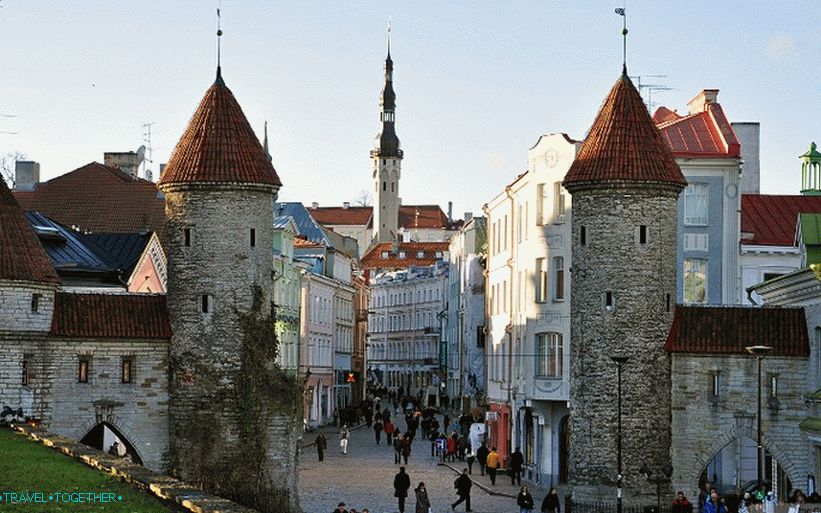 Church of sv. Of the spirit (in the center)
Church of sv. Of the spirit (in the center)
Church of sv. Spirit – an old church of the 14th century. In the old days it religious building was the main temple for the simple townspeople. The church stands out with an interesting wooden finish. the interior of the clock and the 17th century on the facade.
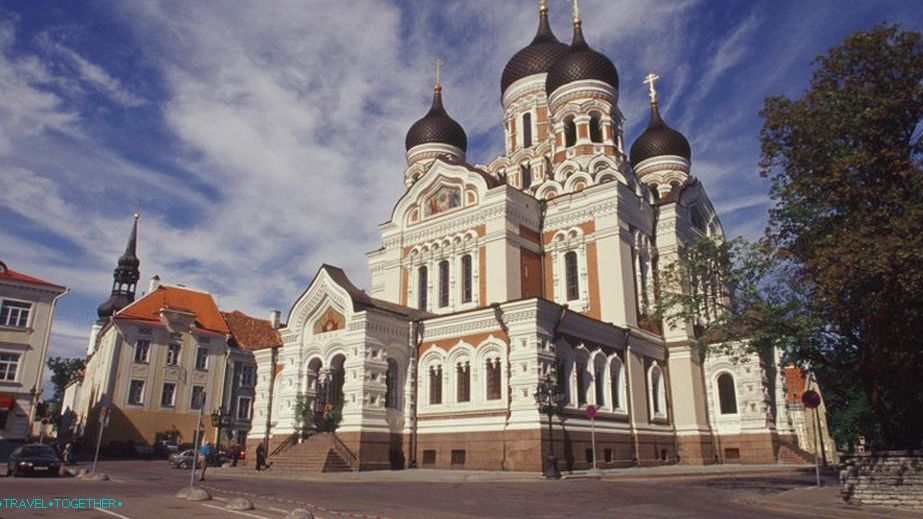 Alexandra Temple Nevsky in Tallinn
Alexandra Temple Nevsky in Tallinn
The Alexander Nevsky Church is the main Orthodox church in Tallinn. The church was built in the early 20th century. Differs in rich internal decoration Under the domes there are 11 bells.
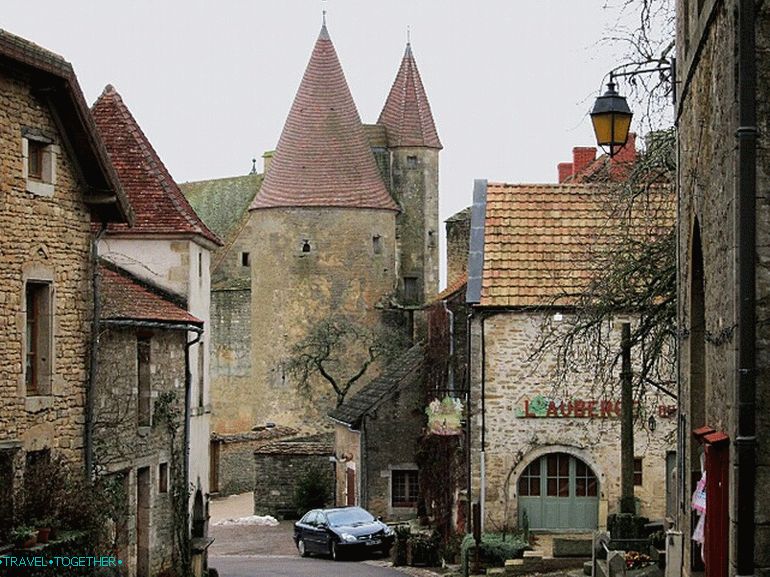
Tallinn Attractions
Tallinn is a city rich in interesting and distinctive places. Here is some of them:
- Kadriorg – a masterpiece of Baroque, a wonderful palace complex, built by Peter I for his wife, Catherine. Now here there is an art museum. Kadriorg Palace can boast many paintings of 16-20 centuries. And surely he is one of the largest and most interesting art museums Baltic States.
- The building of the Great Guild, in which the state historical Museum. This house dates back to the 15th century and was the residence of the guild of the most influential merchants.
- Kick-in-de-Kök Tower – a 38-meter-high medieval tower built in the 15th century. Here you can look at interesting expositions on the city fortifications and weapons.
- Inspection Patkuli, located in the northern part of Vyshgorod (Toompea).
- Tallinn Zoo is one of the largest in the Baltics, located in Veskimetsa park. Great place for family recreation. The ticket price is very affordable: adults – 5 euro, children – 3 euros.
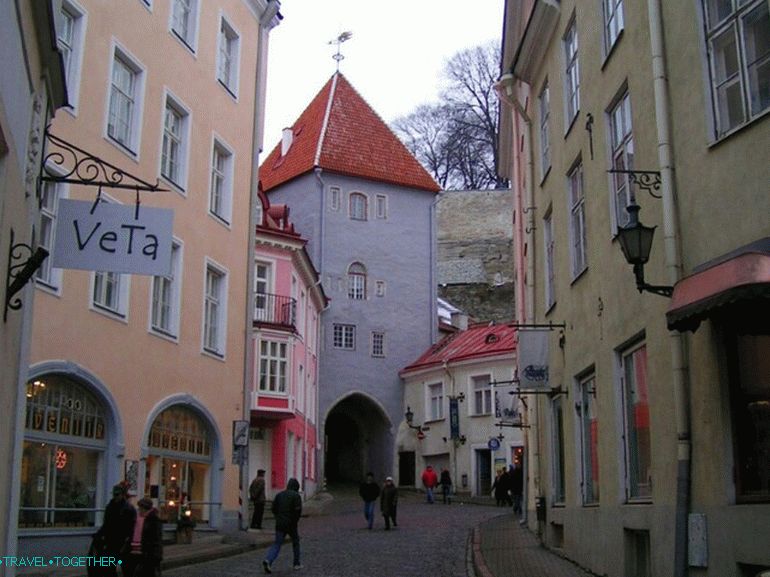 City gate
City gate
- Tallinn TV Tower. You can climb it and look at city from a height of 170 meters.
- Freedom Square is one of the symbols of independent Estonia. Located on the edge of the historic center.
- Helemann Tower – 14th century watchtower climb and walk along the city wall.
- Maiden’s Tower – a medieval tower of the 14th century with a museum and original cafe.
- Keismmae Tower – a medieval stone tower of the 14th century, which can be rented for various events.
- Viru Gate – the city gate to the Old Town, located on Viru street. The gate was built in the 14th century. Although most of the gate was destroyed, there are two guard towers that are among the most recognizable symbols Tallinn
- Kaarli Church on Toompea Hill – one of the most beautiful “New” churches of Tallinn, built in neo-Romanesque style in 19 century.
- Kalamaja – a fishing area, which is adjacent to the historic center. This is a district of old multicolored wooden houses, street. cafe, youth and bohemia.
Of course, only these places of interest of Tallinn are not is limited. It is a city rich in discoveries, in which always can find something new!
Video – Tallinn
Maps and guides
Detailed map of Tallinn (download) Transport card






